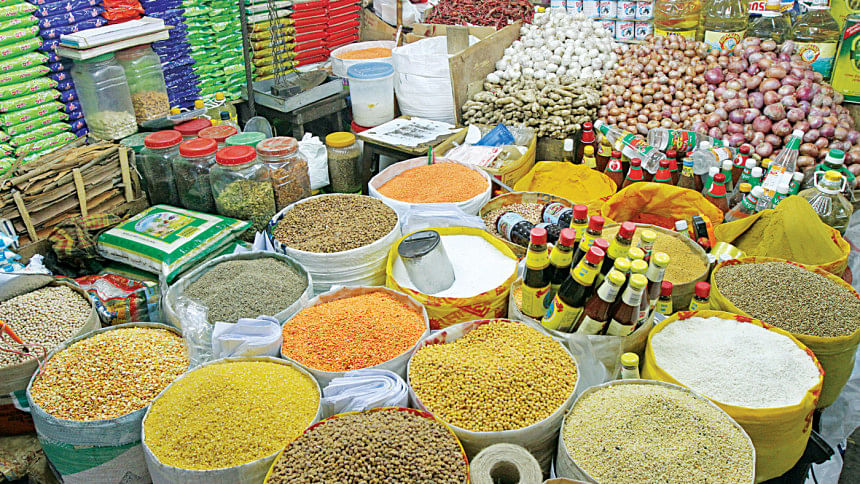Food inflation highest in 12 years

Inflation advanced 23 basis points in August to 9.92 percent propelled by food inflation, which hit a 12-year-high -- laying bare the magnitude of the cost of living crisis staring down on the poor and the low-income people.
In August, food inflation soared 278 basis points to 12.54 percent -- the highest since October 2011, when it stood at 12.82 percent, according to data published yesterday by the Bangladesh Bureau of Statistics.
Food inflation was more pronounced in rural areas, where it stood at 12.71 percent, up from 9.82 percent in July.
August's data means inflation averaged 9.40 percent in 2023 -- at a time when countries around the world and closer to home are snuffing it out.
Take the case of crisis-ridden Sri Lanka, whose key inflation rate eased to 4 percent in August from 6.3 percent a month earlier. Stunningly, food inflation reached a negative 4.8 percent in August, while non-food inflation was 8.7 percent.
India's inflation data for August will be published tomorrow, but a Reuters poll of 45 economists predicted the consumer price index stood at 7 percent in August, down from 7.44 percent in July, on account of cooling vegetable prices after government subsidies and a ban on exports of some cereals.
Coincidentally, India's decisions to ban the export of some varieties of rice and impose a 40 percent export duty on onion and a forthcoming ban on sugar exports for the first time in seven years are ricocheting across the border and fanning food inflation.
"India's export ban on certain food items has affected us directly," said Zahid Hussain, a former lead economist of the World Bank's Dhaka office.
Another reason for the spiralling food prices is Russia's pulling out of the Black Sea grain deal in July. The deal allowed war-torn Ukraine to ship grain through the Black Sea to parts of the world. More than 32 million metric tonnes of corn, wheat and other grains were exported by Ukraine under the arrangement.
"This has caused instability in the global market as Ukraine is a big supplier of wheat," Hussain said.
Bangladesh largely relies on imports of wheat, a staple food item.
The continued appreciation of the dollar against the taka is also fuelling inflationary pressure as Bangladesh is reliant on imports for many food items.
"The dollar rate is on the rise and that is having a direct impact on food imports."
Despite the increase in the rate of the dollar, the supply of greenbacks has not increased, Hussain said.
"That is because the adjustments in the dollar rate are not market-based -- the official rate is lower than the market rate. People are thinking that if they delay bringing their dollars to Bangladesh, they will get a higher rate. That expectation is now baked in the system, so the inflation pressure is sustained."
Then there are major problems with market management at home.
"We see sudden price hikes of food items every other day and the spike seems deliberate and targeted. It shows that the market is being manipulated but all of the government's steps so far in addressing it has been surface level," Hussain said.
Mustafizur Rahman, a distinguished fellow at the Centre for Policy Dialogue, also blamed the poor market management by the authorities for the spiralling food prices.
"Prices of commodities have fallen in the global market but we see no reflection of that in our local market and that is because market management is found wanting."
From the import point and the producers' end to the consumers' end, there is a big difference in prices. The authorities should have worked to narrow this difference.
Ever so often attempts are being made to influence the market but the government's efforts to this end have not been successful, Rahman added.
"Those responsible for market manipulation -- those business groups are left untouched. It is hard to believe that the commerce ministry, the NBR, the Tariff Commission, the Competition Commission do not know who manipulates the market and how they do it," Hussain added.
Meanwhile, non-food inflation dropped 152 basis points to 7.95 percent in August, with the drop more pronounced in rural areas.
"This is just a base effect -- non-food inflation is already high as it is from the leap in the first round," Rahman said.
In urban areas though, non-food inflation is higher (8.48 percent), but the headline inflation is lower than in rural areas and overall: 9.63 percent.
"The purchasing power and the quality of life of people from the low-income segment have eroded much and it is a vicious cycle. To compound matters, their salary is increasing at a lower rate than inflation," Rahman said.
In August, the wage rate increased by 7.58 percent, whereas in Dhaka, it increased by just 5.8 percent -- the lowest among all the divisions.

 For all latest news, follow The Daily Star's Google News channel.
For all latest news, follow The Daily Star's Google News channel. 



Comments